《UNIX編程環境》(The UNIX Programming Envirment)英文原版[PDF] 簡介: 中文名 : UNIX編程環境 原名 : The UNIX Programming Envirment 作者 : Brian W.Kernighan, Rob Pike 圖書分類 : 軟件 資源格式 : PDF 版本 : 英文原版 出版社 : Prentice hall 書號 : 0-13-937681-X 發行時間 : 1984年3月 地區 : 美國 語言 : 英文
電驢資源下載/磁力鏈接資源下載:
- 下載位址: [www.ed2k.online][Unix編程環境]The.unix.programming.envirment英文版.pdf
- 下載位址: [www.ed2k.online][Unix編程環境]The.unix.programming.envirment英文版.djvu
全選
"《UNIX編程環境》(The UNIX Programming Envirment)英文原版[PDF]"介紹
中文名: UNIX編程環境
原名: The UNIX Programming Envirment
作者: Brian W.Kernighan, Rob Pike
圖書分類: 軟件
資源格式: PDF
版本: 英文原版
出版社: Prentice hall
書號: 0-13-937681-X
發行時間: 1984年3月
地區: 美國
語言: 英文
簡介:
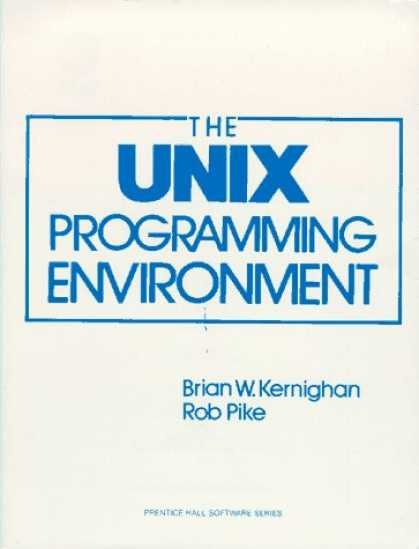
本書對UNIX操作系統的編程環境做了詳細而深入的討論,內容包括UNIX的文件系統、Shell、過濾程序、I/O編程、系統調用等,並對UNIX中的程序開發方法做了有針對性的指導。本書內容深入淺出,實例豐富,無論是UNIX系統的初學者還是專業人員都可從本書受益。本書亦可作為大學生、研究生學習UNIX的教材。
Product Description
Most of the book is devoted to discussions of individual tools, but throughout run the themes of combining programs and of using programs to build programs--emphasizing how they fit in the environment.
From the Publisher
Designed for first-time and experienced users, this book describes the UNIX®programming environment and philosophy in detail. Readers will gain an understanding not only of how to use the system, its components, and the programs, but also how these fit into the total environment.
The Unix Programming Environment is a book written by Brian W. Kernighan and Rob Pike, both of Bell Labs. It is considered an important and early document of the Unix operating system. Often considered "the Bible"[by whom?], it is considered the most authoritative work on Unix.[citation needed] It was first published in 1984 by Prentice Hall.
The book starts off with an introduction to Unix for beginners. Next, it goes into the basics of the file system and shell. The reader is led through topics ranging from the use of filters, to how to use C for programming robust Unix applications, and the basics of grep, sed, make, and awk. The book closes with a tutorial on making a programming language parser with yacc and how to use troff with ms and mm to format documents, the preprocessors tbl, eqn, and pic, and making man pages with the man macro set. The appendices cover the ed editor and the abovementioned programming language, named hoc, which stands for "high-order calculator".
The book is perhaps most valuable for its exposition of the Unix philosophy of small cooperating tools with standardized inputs and outputs, a philosophy that also shaped the end-to-end philosophy of the Internet.[citation needed] It is this philosophy, and the architecture based on it, that has allowed open source projects to be assembled into larger systems such as Linux, without explicit coordination between developers.
The book was written before ANSI C was first drafted, therefore the programs in the book are nonstandard and follow K&R style. However, the source code available on the book's website has been updated for ANSI C conformance (but uses the implicit int rule, which is disallowed in C99).
ISBN 0-13-937681-X (paperback), 0-13-937699-2 (hardback).
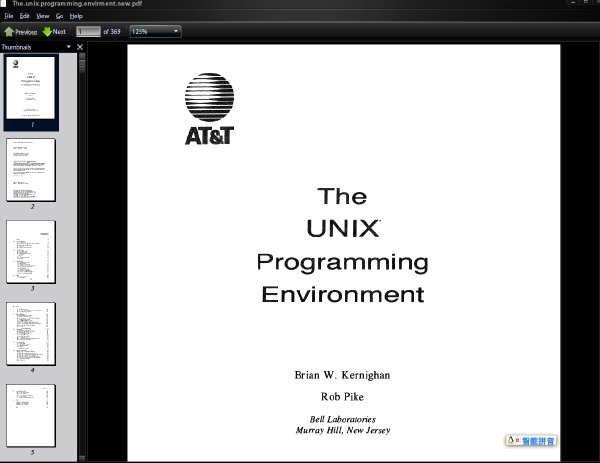
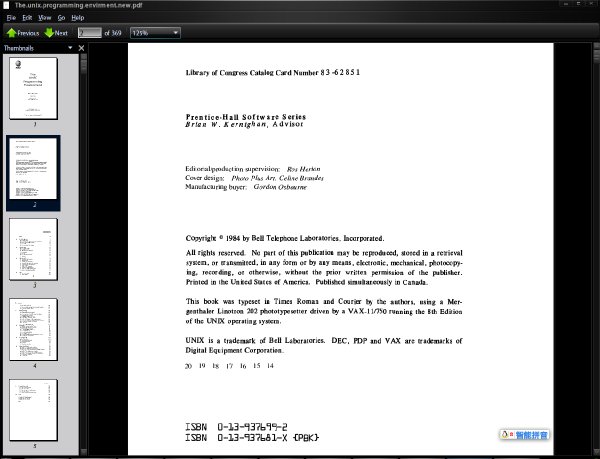
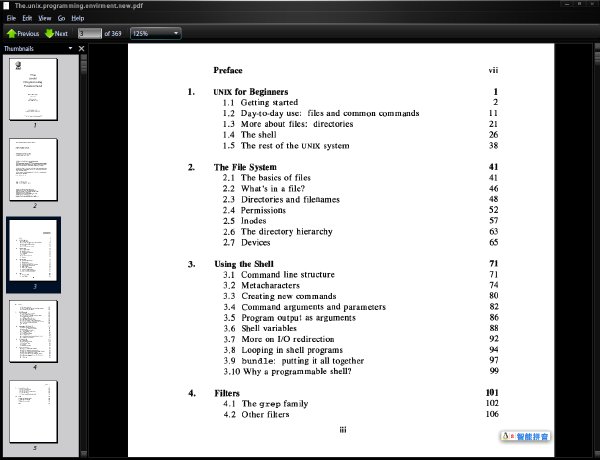
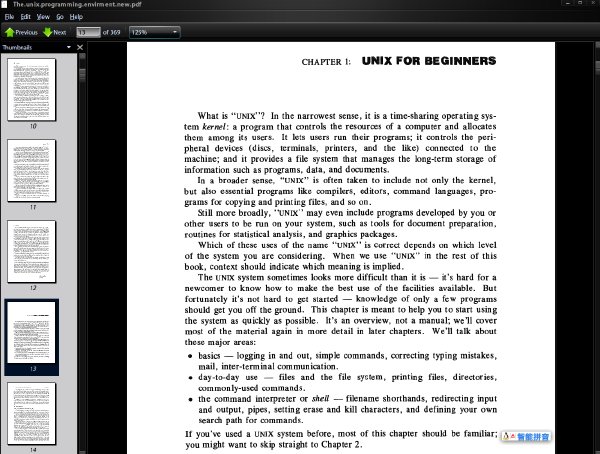
目錄:
CONTENTS
Preface ee
VII
1. UNIX for Beginners 1
1.1 Getting started 2
1.2 Day-to-day use: files and common commands 11
1.3 More about files: directories 21
1.4 The shell 26
1.5 The rest of the UNIX system 38
2. The File System 41
2.1 The basics of files 41
2.2 What's in a file? 46
2.3 Directories and filenames 48
2.4 Permissions 52
2.5 Inodes 57
2.6 The directory hierarchy 63
2.7 Devices 65
3. Using the Shell 71
3.1 Command line structure 71
3.2 Metacharacters 74
3.3 Creating new commands 80
3.4 Command arguments and parameters 82
3.5 Program output as arguments 86
3.6 Shell variables 88
3.7 More on I/O redirection 92
3.8 Looping in shell programs 94
3.9 bund 1 e: putting it all together 97
3.10 Why a programmabJe shell? 99
4. Filters 101
4.1 The grep family 102
4.2 Other filters 106iv CONTENTS
4.3 The stream editor sed
4.4 The awk pattern scanning and processing language
4.5 Good files and good filters
Shell Programming
5.1 Customizing the cal command
5.2 Which command is which?
5.3 while and until loops: watching for things
5.4 Traps: catching interrupts
5.5 Replacing a file: overwrite
5.6 zap: killing processes by name
5.7 The pick command: blanks vs. arguments
5.8 The news command: community service messages
5.9 get and put: tracking file changes
5.10 A look back
Programming with Standard I/O
6.1 Standard input and output: vis
6.2 Program arguments: vis version 2
6.3 File access: vis version 3
6.4 A screen-at-a-time printer: p
6.5 An example: pick
6.6 On bugs and debugging
6.7 An example: zap
6.8 An interactive file comparison program: idiff
6.9 Accessing the environment
UNIX System Calls
7.1 Low-level I/O
7.2 File system: directories
7.3 File system: inodes
7 . 4 Processes
7.5 Signals and interrupts
Program Development
8.1 Stage 1: A four-function calculator
8.2 Stage 2: Variables and error recovery
8.3 Stage 3: Arbitrary variable names; built-in functions
8.4 Stage 4: Compilation into a machine
8.5 Stage 5: Control flow and relational operators
8.6 Stage 6: Functions and procedures; input/output
8.7 Performance evaluation
8.8 A look back
9. Document Preparation 289
9.1 The ms macro package 290
9.2 The troff level 297
9.3 The tbl and eqn preprocessors 301
9.4 The manual page 308
9.5 Other document preparation tools 313
10. Epilog 315
Appendix 1: Editor Summary 319
Appendix 2: hoc Manual 329
Appendix 3: hoc Listing 335
Index
4.3 The stream editor sed
4.4 The awk pattern scanning and processing language
4.5 Good files and good filters
Shell Programming
5.1 Customizing the cal command
5.2 Which command is which?
5.3 while and until loops: watching for things
5.4 Traps: catching interrupts
5.5 Replacing a file: overwri te
5.6 zap: killing processes by name
5.7 The pick command: blanks vs. arguments
5.8 The news command: community service messages
5.9 get and put: tracking file changes
5.10 A look back
Programming with Standard I/O
6.1 Standard input and output: vis
6.2 Program arguments: vis version 2
6.3 File access: vis version 3
6.4 A screen-at-a-time printer: p
6.5 An example: pick
6.6 On bugs and debugging
6.7 An example: zap
6.8 An interactive file comparison program: idiff
6.9 Accessing the environment
UNIX System Calls
7.1 Low-level I/O
7.2 File system: directories
7.3 File system: inodes
7 .4 Processes
7.5 Signals and interrupts
Program Development
8.1 Stage 1: A four-function calculator
8.2 Stage 2: Variables and error recovery
8.3 Stage 3: Arbitrary variable names; built-in functions
8.4 Stage 4: Compilation into a machine
8.5 Stage 5: Control flow and relational operators
8.6 Stage 6: Functions and procedures; input/output
8.7 Performance evaluation
8.8 A look back
9. Document Preparation 289
9. 1 The ros macro package 290
9.2 The troff level 297
9.3 The tbl and eqn preprocessors 301
9.4 The manual page 308
9.5 Other document preparation tools 313
10. Epilog 315
Appendix 1: Editor Summary 319
Appendix 2: hoc Manual 329
Appendix 3: hoc Listing 335
原名: The UNIX Programming Envirment
作者: Brian W.Kernighan, Rob Pike
圖書分類: 軟件
資源格式: PDF
版本: 英文原版
出版社: Prentice hall
書號: 0-13-937681-X
發行時間: 1984年3月
地區: 美國
語言: 英文
簡介:

本書對UNIX操作系統的編程環境做了詳細而深入的討論,內容包括UNIX的文件系統、Shell、過濾程序、I/O編程、系統調用等,並對UNIX中的程序開發方法做了有針對性的指導。本書內容深入淺出,實例豐富,無論是UNIX系統的初學者還是專業人員都可從本書受益。本書亦可作為大學生、研究生學習UNIX的教材。
Product Description
Most of the book is devoted to discussions of individual tools, but throughout run the themes of combining programs and of using programs to build programs--emphasizing how they fit in the environment.
From the Publisher
Designed for first-time and experienced users, this book describes the UNIX®programming environment and philosophy in detail. Readers will gain an understanding not only of how to use the system, its components, and the programs, but also how these fit into the total environment.
The Unix Programming Environment is a book written by Brian W. Kernighan and Rob Pike, both of Bell Labs. It is considered an important and early document of the Unix operating system. Often considered "the Bible"[by whom?], it is considered the most authoritative work on Unix.[citation needed] It was first published in 1984 by Prentice Hall.
The book starts off with an introduction to Unix for beginners. Next, it goes into the basics of the file system and shell. The reader is led through topics ranging from the use of filters, to how to use C for programming robust Unix applications, and the basics of grep, sed, make, and awk. The book closes with a tutorial on making a programming language parser with yacc and how to use troff with ms and mm to format documents, the preprocessors tbl, eqn, and pic, and making man pages with the man macro set. The appendices cover the ed editor and the abovementioned programming language, named hoc, which stands for "high-order calculator".
The book is perhaps most valuable for its exposition of the Unix philosophy of small cooperating tools with standardized inputs and outputs, a philosophy that also shaped the end-to-end philosophy of the Internet.[citation needed] It is this philosophy, and the architecture based on it, that has allowed open source projects to be assembled into larger systems such as Linux, without explicit coordination between developers.
The book was written before ANSI C was first drafted, therefore the programs in the book are nonstandard and follow K&R style. However, the source code available on the book's website has been updated for ANSI C conformance (but uses the implicit int rule, which is disallowed in C99).
ISBN 0-13-937681-X (paperback), 0-13-937699-2 (hardback).




目錄:
CONTENTS
Preface ee
VII
1. UNIX for Beginners 1
1.1 Getting started 2
1.2 Day-to-day use: files and common commands 11
1.3 More about files: directories 21
1.4 The shell 26
1.5 The rest of the UNIX system 38
2. The File System 41
2.1 The basics of files 41
2.2 What's in a file? 46
2.3 Directories and filenames 48
2.4 Permissions 52
2.5 Inodes 57
2.6 The directory hierarchy 63
2.7 Devices 65
3. Using the Shell 71
3.1 Command line structure 71
3.2 Metacharacters 74
3.3 Creating new commands 80
3.4 Command arguments and parameters 82
3.5 Program output as arguments 86
3.6 Shell variables 88
3.7 More on I/O redirection 92
3.8 Looping in shell programs 94
3.9 bund 1 e: putting it all together 97
3.10 Why a programmabJe shell? 99
4. Filters 101
4.1 The grep family 102
4.2 Other filters 106iv CONTENTS
4.3 The stream editor sed
4.4 The awk pattern scanning and processing language
4.5 Good files and good filters
Shell Programming
5.1 Customizing the cal command
5.2 Which command is which?
5.3 while and until loops: watching for things
5.4 Traps: catching interrupts
5.5 Replacing a file: overwrite
5.6 zap: killing processes by name
5.7 The pick command: blanks vs. arguments
5.8 The news command: community service messages
5.9 get and put: tracking file changes
5.10 A look back
Programming with Standard I/O
6.1 Standard input and output: vis
6.2 Program arguments: vis version 2
6.3 File access: vis version 3
6.4 A screen-at-a-time printer: p
6.5 An example: pick
6.6 On bugs and debugging
6.7 An example: zap
6.8 An interactive file comparison program: idiff
6.9 Accessing the environment
UNIX System Calls
7.1 Low-level I/O
7.2 File system: directories
7.3 File system: inodes
7 . 4 Processes
7.5 Signals and interrupts
Program Development
8.1 Stage 1: A four-function calculator
8.2 Stage 2: Variables and error recovery
8.3 Stage 3: Arbitrary variable names; built-in functions
8.4 Stage 4: Compilation into a machine
8.5 Stage 5: Control flow and relational operators
8.6 Stage 6: Functions and procedures; input/output
8.7 Performance evaluation
8.8 A look back
9. Document Preparation 289
9.1 The ms macro package 290
9.2 The troff level 297
9.3 The tbl and eqn preprocessors 301
9.4 The manual page 308
9.5 Other document preparation tools 313
10. Epilog 315
Appendix 1: Editor Summary 319
Appendix 2: hoc Manual 329
Appendix 3: hoc Listing 335
Index
4.3 The stream editor sed
4.4 The awk pattern scanning and processing language
4.5 Good files and good filters
Shell Programming
5.1 Customizing the cal command
5.2 Which command is which?
5.3 while and until loops: watching for things
5.4 Traps: catching interrupts
5.5 Replacing a file: overwri te
5.6 zap: killing processes by name
5.7 The pick command: blanks vs. arguments
5.8 The news command: community service messages
5.9 get and put: tracking file changes
5.10 A look back
Programming with Standard I/O
6.1 Standard input and output: vis
6.2 Program arguments: vis version 2
6.3 File access: vis version 3
6.4 A screen-at-a-time printer: p
6.5 An example: pick
6.6 On bugs and debugging
6.7 An example: zap
6.8 An interactive file comparison program: idiff
6.9 Accessing the environment
UNIX System Calls
7.1 Low-level I/O
7.2 File system: directories
7.3 File system: inodes
7 .4 Processes
7.5 Signals and interrupts
Program Development
8.1 Stage 1: A four-function calculator
8.2 Stage 2: Variables and error recovery
8.3 Stage 3: Arbitrary variable names; built-in functions
8.4 Stage 4: Compilation into a machine
8.5 Stage 5: Control flow and relational operators
8.6 Stage 6: Functions and procedures; input/output
8.7 Performance evaluation
8.8 A look back
9. Document Preparation 289
9. 1 The ros macro package 290
9.2 The troff level 297
9.3 The tbl and eqn preprocessors 301
9.4 The manual page 308
9.5 Other document preparation tools 313
10. Epilog 315
Appendix 1: Editor Summary 319
Appendix 2: hoc Manual 329
Appendix 3: hoc Listing 335
- 上一頁:《實戰Nginx:取代Apache的高性能Web服務器》(實戰Nginx:取代Apache的高性能Web服務器)(張宴)掃描版[PDF]
- 下一頁:《系統分析師技術指南-附帶個人收集的大禮包》(張友生 徐鋒)掃描版[PDF]
相關資源:
- [人文社科]《中世紀歐洲經濟社會史》(Ecnomic and Social History of Medieval Europe)((比)亨利·皮郎)中譯本,掃描版[PDF]
- [人文社科]《華盛頓的全球賭博》(The Global Gamble)((英)彼得·高恩)中譯本,掃描版[PDF]
- [文學圖書]《阿瑟·薩維爾勳爵的罪行及其他故事》(Lord Arthur Saviles Crime and Other Stories)((英)奧斯卡·王爾德)英文文字版[PDF]
- [人文社科]《偉大的羅馬戰爭》(Great Battles of Rome)硬盤版
- [其他圖書]《韋氏英語慣用法詞典》(Merriam-Websters Dictionary of English Usage)[PDF]
- [計算機與網絡]《Premiere Pro視頻編輯實用教程》掃描版[PDF]
- [經濟管理]《留住好員工,吸引新員工》掃描版[PDF]
- [人文社科]中村中(Nakamura Ataru) -《あしたは晴れますように》專輯[MP3]
- [人文社科]《妙法蓮華經淺釋》掃描版[PDF]
- [人文社科]《單車二勢力》(Bike)[黑亮出品]更新至2009.08.08[RMVB]
- [軟件綜合]全是綠色軟件總有你需要的(不是精品我不發)
- [計算機與網絡]《The Internet Of Things》英文版[PDF]
- [生活圖書]《鹽城名老中醫經驗精華》掃描版[PDF]
- [硬盤游戲]《聖誕老人大戰銀行家》(Santa Vs. Banker )v1.2.0.0硬盤版[壓縮包]
- [生活百科]《獨生男孩怎麼養》 岳賢倫
- [人文社科]三聯生活周刊-2012年第51期PDF
- [軟件綜合]【DirectX】【完整版】【安裝包】【DX9、DX10、DX11】【X86、X64】【游戲、設計必備】
- [英語學習資料]《彭蒙惠英語Advanced》(Studio Classroom Advanced)9月刊[Bin]
- [文學圖書]《萍蹤俠影錄》(梁羽生)文字版[PDF]
- [硬盤游戲]《國際刑警之混沌博士的蹤跡》(Interpol The Trail of Dr. Chaos)硬盤版
- 《金牌網管師(初級)中小型企業網絡組建、配置與管理全國網管師職業評定》掃描版[PDF]
- 《PHP動態網頁設計與制作案例教程》掃描版[PDF]
- 《讓Oracle跑得更快——Oracle 10g性能分析與優化思路》掃描版[PDF]
- 《CATIA V5 模具設計實例精解》高清掃描本[PDF]
- 《月掙5000,網上開店立即GO》(鐘聲)文字版[PDF]
- 《Linux開發工具箱》掃描版[PDF]
- 《LTE,增強型LTE 和WiMAX》(LTE, LTE-Advanced and WiMAX: Towards IMT-Advanced Networks)英文文字版[PDF]
- 《PHP 5 權威編程 (高清300dpi版+清晰版PDF)》(PHP5
- 《新編英國平面設計基礎教程》掃描版[PDF]
- 《敏捷估計與規劃》(Agile Estimating and Planning)英文文字版[PDF]
- 《精通Visual C++數字圖像處理典型算法及實現(第2版)》掃描版[PDF]
- 《Scaling CouchDB (第1版)》(Scaling CouchDB: Replication,
免責聲明:本網站內容收集於互聯網,本站不承擔任何由於內容的合法性及健康性所引起的爭議和法律責任。如果侵犯了你的權益,請通知我們,我們會及時刪除相關內容,謝謝合作! 聯系信箱:[email protected]
Copyright © 電驢下載基地 All Rights Reserved



